Jensen Manor in Panama
In 2013, the Panamanian Fine Coffee Association introduced the geisha variety to the Peterson family of Panama for the first time in 2004, and the international community has been crazy about Geisha ever since. Also known as "the champagne of the coffee world".
The Best Panamanian Coffee Award awarded by SCAP has a new finalist! It's Carl Jensen's Jensen Village horticultural geisha! Janson Geisha should be rarely heard of in China, because this manor is mainly for domestic sales and is not being done. Export; in addition, more than 50% of the manor grows Ge??isha coffee and is the second largest producer of Geisha in Panama. Carl Jensen, originally a Swiss, fell in love with the peaks and valleys of Volcan in Panama in the early 1940s and began growing coffee beans and animal husbandry on Panama's first automated farm after marrying his wife Margaret.
Jensen Farm not only has its own coffee processing plant to process coffee cherries, but also uses the best roasting methods to show the perfect cup test results.
In order to demand perfect quality, Jensen Manor will be paid $4 a day, strictly requiring workers to harvest only the most mature and beautiful ripe red coffee fruits. This area used to grow alpine avocado, which was transported directly to the capital Panama City after harvest. Because of its special flavor and dense taste, it is a high price of fruit.
Now this area is dominated by coffee, and alpine avocado will be mixed among them. The manor fertilizes about 4 times a year. For the first time, after the coffee fruit is harvested, it is mainly nitrogen and phosphorus, and then paired with other trace elements.
Others will use appropriate organic fertilizers in July and September. For the last time, three weeks before the harvest period, foliar fertilizer imported from Canada will be sprayed for the final nutritional supply. No fertilizer will be applied throughout the coffee harvest season.
Sun-dried beans will be dried naturally for 4 days, depending on the weather. When the moisture content is about 40%, it will take more than 12 days to slowly dry the raw beans by machine. After each batch of raw beans are dried, they will be loaded into black grain bags, plus a layer of PP plastic woven bags commonly known as fertilizer bags, which will be cooked in the bean warehouse for 3 months to effectively prevent moisture and block light. The inherent advantages of the farm make the geisha show the most perfect flavor.
Dry aroma: dried fruit, pineapple, orange, peach, lemon.
Wet fragrance: sweet peach, blueberry, strawberry, sugarcane, citrus, magnolia
Sipping: the acidity of sweet orange, tropical fruit and ripe apple is accompanied by the fruit aroma of sweet peach, with obvious flavor lines, thick glycol and excellent cleanliness.
Important Notice :
前街咖啡 FrontStreet Coffee has moved to new addredd:
FrontStreet Coffee Address: 315,Donghua East Road,GuangZhou
Tel:020 38364473
- Prev

Characteristics of flavor introduction in five major producing areas of Nicaraguan coffee.
Communication of professional baristas Please pay attention to Coffee Workshop (Wechat official account cafe_style) Nicaraguan coffee is mainly produced in the central and northern parts of Nicaragua, covered with volcanic ash and shaded by trees, resulting in high-quality Nicaraguan coffee, which has a mediocre, mild flavor and is suitable for mixed coffee. Shade planting is its characteristic, while coffee beans are washed and dried in the sun.
- Next

Honduras to provide the world's perfect coffee and unique coffee aroma, the quantity of multi-quality essence!
Professional coffee knowledge exchange more coffee bean information please follow the coffee workshop (Wechat official account cafe_style) there are 280000 hectares of coffee plantations in Honduras, mainly small coffee businesses, most of which are smaller than 3.5 hectares, accounting for 60% of Hongguo's production. In the coffee garden, men and women collect coffee beans with their hands, then handle them carefully and
Related
- Does Rose Summer choose Blue, Green or Red? Detailed explanation of Rose Summer Coffee plots and Classification in Panamanian Jade Manor
- What is the difference between the origin, producing area, processing plant, cooperative and manor of coffee beans?
- How fine does the espresso powder fit? how to grind the espresso?
- Sca coffee roasting degree color card coffee roasting degree 8 roasting color values what do you mean?
- The practice of lattes: how to make lattes at home
- Introduction to Indonesian Fine Coffee beans-- Java Coffee producing area of Indonesian Arabica Coffee
- How much will the flavor of light and medium roasted rose summer be expressed? What baking level is rose summer suitable for?
- Introduction to the characteristics of washing, sun-drying or wet-planing coffee commonly used in Mantenin, Indonesia
- Price characteristics of Arabica Coffee Bean Starbucks introduction to Manning Coffee Bean Taste producing area Variety Manor
- What is the authentic Yega flavor? What are the flavor characteristics of the really excellent Yejasuffi coffee beans?

